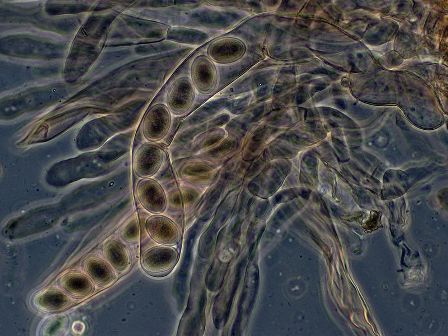Birds, bees, and fruiting bodies
Most fungi can reproduce sexually as well as asexually, and
the false morel is no exception. In the
asexual life cycle, the mycelium produces spores called conidia
in structures called conidiophores (right). The
spores then germinate into more mycelium. Sexual
reproduction is a little more interesting and produces the things we call
mushrooms. It usually only occurs when
environmental conditions are bad. An example of
this is the black bread mold
Rhizopus stolonifer. It uses asexual reproduction
when it is growing on bread because there is plenty of
nourishment. That is why we don't usually see mushrooms
sprouting from pieces of moldy bread.

Like most fungi,
Gyromitra esculenta spends most of its life as a mycelium.
To reproduce sexually, the mycelium forms a fruiting
body, a conspicuous mushroom that most people associate with
fungi. The false morel fruiting body consists
of a short white stem and a large cap with many wrinkles and
folds, and a chambered interior. The purpose of the fruiting body is to
lift spores into the air so they can be distributed by the wind.
The surface of the mushroom produces haploid (one set of
chromosomes) spores in structures
called asci,(pronounced ASS-eye) pictured above. The asci are tube-shaped with a
cap at the end, and they contain eight spores each.
All fungi in the ascomycota reproduce this way. The
picture above is a generalized ascus structure. The spores
of Gyromitra esculenta are different, however.
The false morel's spores are ellipse shaped, smooth, and have
an oil drop at each end. (Below)
They can be anywhere from 18x10µm to
30x13.5µm.
When the spores mature the
operculum at
the end of the ascus rips open, and they are released forcibly into the air.
Sometimes a cloud
of spores can even be seen rising from the mushroom.

Two haploid mycelium fuse, but only the cytoplasms, not the nuclei. This process is called plasmogamy. When conditions are right, the new mycelium, called a dikaryotic mycelium, forms a fruiting body. In the fruiting body, the nuclei fuse in a process called karyogamy and form a diploid cell. Meiosis occurs, haploid spores are produced, and the life cycle starts again. There is no way to know exactly when a fruiting body will pop up (Yet! Check when this site was updated). However, it has been found that when nutrients are low and water is abundant, mushrooms are more apt to form. A diagram of the life cycle is shown below.

Life cycle visual taken from lecture notes by Dr. Tom Volk
Since the process is somewhat ambiguous, it is hard to say exactly when in the year the fruiting bodies will appear. In the upper Midwest the season for false morels is April and May. This depends heavily on environmental factors. These factors also affect where morels can be found.
To learn about where these mushrooms are usually found and why, see the habitat page.
Pictures on this page taken from Wikipeida.com.
HOME